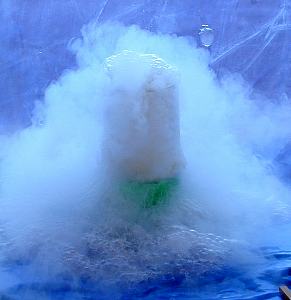1. General precautions for all use of cryogenic liquids
- At all times, HAVE A PLAN of what you will do if....
|
|
|
- a pressurized Dewar spontaneously vents?
- you freeze your watchband or wedding band to your finger?
- the funnel (which you should not be using) freezes and spews liquid nitrogen upward into your
face?
- 160 L of LN2 for whatever reason falls onto
its side? (It happens. It's scary and unpleasant and
could easily be quite disastrous.)
|
 Liquid cryogens can cause terrible "burns."
(Death of living tissue caused by the extreme cold.) Streams of super cooled gasses
and metal objects cooled to liquid nitrogen temperatures can be even more dangerous than the liquid.
Severe and permanent eye damage can occur from exposure to liquid cryogens or super cooled gasses.
Hand protection and goggles (not safety
glasses) should be worn when dispensing and handling liquid cryogens. When handling
large quantities, a full length apron will minimize the chance of a spill going into your
shoes, where it might destroy some cubic centimeters of flesh before you can get your
shoes and socks off. Persons using a tipper to dispense LN2 should wear a full face
shield over goggles, cryo-gloves, full length cuffless trousers which completely
cover the tops of the shoes (or a full length apron), and shoes which will not permit
liquefied gas to enter them in case of a spill, and which are also quickly removable in
case they do (allow liquid to enter). The correct PPE required for your application should
be spelled out on the hazard assessment for your area. Liquid cryogens can cause terrible "burns."
(Death of living tissue caused by the extreme cold.) Streams of super cooled gasses
and metal objects cooled to liquid nitrogen temperatures can be even more dangerous than the liquid.
Severe and permanent eye damage can occur from exposure to liquid cryogens or super cooled gasses.
Hand protection and goggles (not safety
glasses) should be worn when dispensing and handling liquid cryogens. When handling
large quantities, a full length apron will minimize the chance of a spill going into your
shoes, where it might destroy some cubic centimeters of flesh before you can get your
shoes and socks off. Persons using a tipper to dispense LN2 should wear a full face
shield over goggles, cryo-gloves, full length cuffless trousers which completely
cover the tops of the shoes (or a full length apron), and shoes which will not permit
liquefied gas to enter them in case of a spill, and which are also quickly removable in
case they do (allow liquid to enter). The correct PPE required for your application should
be spelled out on the hazard assessment for your area.
|
- Do not use a funnel unless it is specifically designed for use with liquid cryogens.
Appropriate funnels are vented to prevent buildup of gas beneath the funnel, and the top is partially covered
to minimize splashing out of the top of the funnel.
|
|
- Asphyxiation -- argon, helium, and nitrogen are not poisonous;
the air is already about 78% nitrogen (oxygen
makes up about 21%, and trace gases the remaining 1%). However, if sufficient liquid
cryogen is vaporized so as to reduce the oxygen percentage to below 19.5%, you are at
risk of oxygen deprivation. Rapid venting can cause near-total displacement of
normal air, leading to a local concentration of about 100% of the cryogenic gas. Simple
asphyxiants such as argon, helium, and nitrogen do not have good warning properties!
(You might not feel "light-headed," you may simply pass out without any warning
whatsoever. And then die without regaining consciousness.)
|
- Do not store container(s) of liquid cryogens in a
cold room or any other location where a person could physically
enter an anoxic (low oxygen) atmosphere. (Cold rooms have no air changes
and a person entering a room with elevated nitrogen in the air can
quickly pass out and then die within several minutes of entering.
|
|
|





